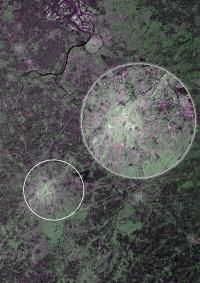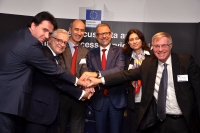Thanks to the European Union's Copernicus programme, vast quantities of satellite data are freely available to manage the environment and benefit European citizens. While this offers a wealth of opportunities, downloading and storing these data involves some complex logistical challenges - but this is about to change.
With such a lot of data available, the European Commission is making efforts to make sure that the process of accessing these data and information is easier so that issues associated with downloading and storing can be avoided.
To this end, the European Commission launched the Copernicus Data and Information Access Services (DIAS).
Following a tender and evaluation process, ESA, acting on behalf of the European Commission, has now signed DIAS contracts with four industrial consortia.
DIAS will give unlimited, free and complete access to Copernicus data and information. DIAS provides a scalable computing and storage environment for third parties. Third parties will be empowered to offer advanced value-adding services integrating Copernicus with their own data and tools to the benefit of their own users.
The contracts, signed by Josef Aschbacher, ESA's Director of Earth Observation Programmes, mean that by the second quarter of 2018, five DIAS, including the one to be developed by EUMETSAT in cooperation with European Centre for Medium-Range Weather Forecasts and Mercator Ocean, will be available to users.
DIAS will not only provide a cloud-based one-stop shop for all Copernicus satellite data and imagery as well as information from the six Copernicus services, but will also give access to sophisticated processing tools and resources.
Philippe Brunet, Director for Space Policy, Copernicus and Defence at EC DG GROW, said, "This is a key milestone in the Copernicus programme.
"We are kick-starting the development of European data access and cloud processing services.
"The vision of the European Commission is that the DIAS platforms will make it even easier for users from various industries and backgrounds to create Copernicus-based applications and services that will benefit people in Europe and around the world."
The four winning consortia are:
Led by Serco Europe, consortium includes OVH, Gael Systems and Sinergise Ltd.
Led by Creotech Instruments, consortium includes Cloud Ferro, Sinergise Ltd, Geomatis SAS, Outsourcing Partner Sp. z o.o., Wroclaw Institute of Spatial Information and Artificial Intelligence Sp. z o.o.
Led by ATOS Integration, consortium includes T-SYSTEM International, DLR, eGEOS, EOX, GAF, Sinergise Ltd, Spacemetric, and Thales Alenia Space.
Led by Airbus Defence and Space, consortium includes Orange SA, Airbus Defence and Space, Geo SA, Capgemini Technology Services SAS, CLS and VITO.
About Copernicus
Led by the European Commission, Copernicus is the largest environmental monitoring programme in the world. It provides a unified system through which a myriad of data are fed into a range of thematic information services designed to benefit the environment, the way we live, humanitarian needs and support effective policy-making for a more sustainable future.
As part of the programme, ESA is responsible for the 'space component', which includes not only the Sentinel satellites but also the network of receiving stations and processing centres through which data are made available for the range of Copernicus services. Copernicus data are free and open to all worldwide.

